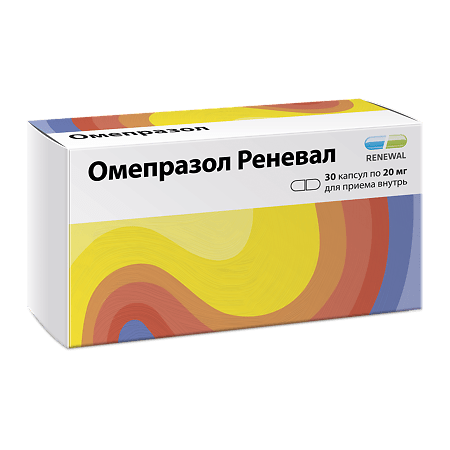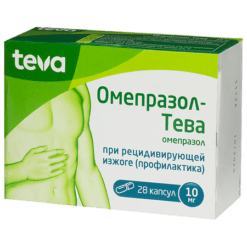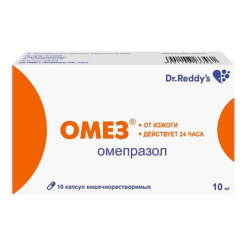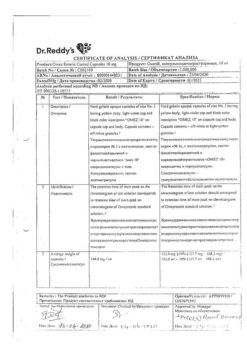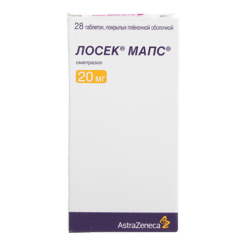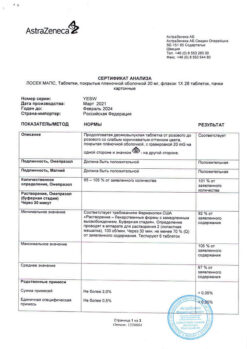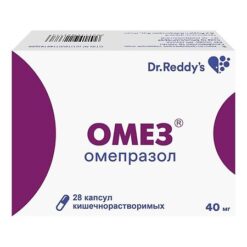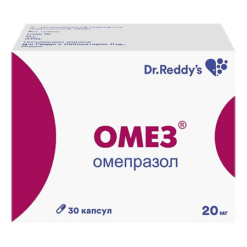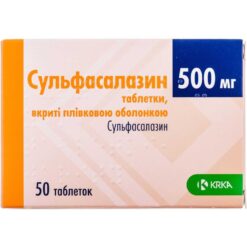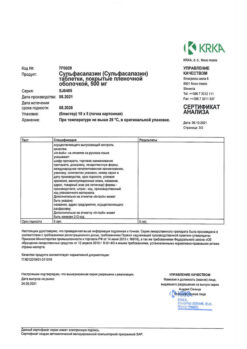No products in the cart.
Omeprazole Reneval, 20 mg 30 pcs.
€3.93 €3.49
EAN: 4603988017891
SKU: 510057
Categories: Medicine, Stomach, intestines, liver, Ulcer and gastritis
Description
Pharmacotherapeutic group: gastric secretion reducing agent – proton pump inhibitor.
ATX code: A02BC01
Pharmacological properties
Pharmacodynamics
Omeprazole is a racemic mixture of two enantiomers, reduces the secretion of hydrochloric acid by specific inhibition of the proton pump of gastric parietal cells. When administered once, it is fast acting and has a reversible inhibition of hydrochloric acid secretion.
Mechanism of action
. Omeprazole is a weak base, converts to its active form in the acidic environment of the tubules of the cells of the parietal layer of the gastric mucosa, where it is activated and inhibits H+/ K+-ATPase of the proton pump. It has a dose-dependent effect on
the last step of hydrochloric acid synthesis, inhibiting both basal and stimulated secretion regardless of the stimulating factor.
Influence on gastric hydrochloric acid secretion
After oral administration of omeprazole once daily, there is rapid and effective inhibition of daytime and nighttime hydrochloric acid secretion, which reaches a maximum within 4 days of treatment.
In patients with duodenal ulcer disease, use of 20 mg of omeprazole causes a sustained reduction of 24-hour gastric acidity by at least 80%. At the same time, a decrease in the average maximum concentration of hydrochloric acid after pentagastrin stimulation by 70% is achieved within 24 hours. Daily oral administration of 20 mg of omeprazole in patients with duodenal ulcer maintains the value of acidity at pH ≥ 3 for 17 hours on average.
The degree of inhibition of hydrochloric acid secretion is proportional to the area under the pharmacokinetic concentration-time curve (AUC) of omeprazole and is not proportional
to the actual plasma concentration of the drug at that time. No tachyphylaxis was observed during treatment with omeprazole.
Action on Helicobacter pylori
Omeprazole has a bactericidal effect on Helicobacter pylori in vitro. Eradication of Helicobacter pylori when using omeprazole in combination with antibacterial agents is accompanied by rapid elimination of symptoms, a high degree of healing of gastrointestinal (GI) mucosal defects and long-term remission of ulcer disease, which reduces the chance of complications such as bleeding as effectively as continuous maintenance therapy.
Other effects associated with inhibiting hydrochloric acid secretion
Patients taking drugs that decrease gastric gland secretion are more likely to have glandular cysts of the stomach floor over a long period of time. The cysts are benign and go away on their own with continued therapy. These phenomena are caused by physiological changes resulting from inhibition of hydrochloric acid secretion.
The decrease in gastric hydrochloric acid secretion by proton pump inhibitors or other gastric acid reducing agents leads to an increase in the growth of normal gut microflora, which in turn may lead to a small increase in the risk of intestinal infections caused by bacteria of the genus Salmonella spp. and Campylobacter spp, and, in hospitalized patients, probably also the bacteria Clostridium difficile.
During treatment with drugs that reduce gastric gland secretion, serum gastrin concentration increases. Due to decreased secretion of hydrochloric acid, plasma concentration of chromogranin A (CgA) increases. Increased plasma concentration of CgA may affect the results of examinations to detect neuroendocrine tumors. To prevent this effect, therapy with proton pump inhibitors should be suspended 5 days before the study of plasma CgA concentration determination. If plasma gastrin and CgA concentrations have not returned to normal values after 5 days, the study should be repeated 14 days after discontinuation of omeprazole.
In pediatric and adult patients on long-term omeprazole an increase in enterochromaffin-like cells was observed, probably related to an increase in serum gastrin concentrations. This phenomenon has no clinical significance.
Pharmacokinetics
Absorption
Omeprazole is rapidly absorbed from the gastrointestinal tract, the maximum concentration (Cmax) in plasma is reached after 1-2 hours. Absorbed in the small intestine usually within 3-6 hours. Bioavailability after a single oral administration is about 40%, after continuous administration once a day bioavailability increases to 60%. Simultaneous intake of food does not affect the bioavailability of omeprazole.
Distribution
The binding of omeprazole to plasma proteins is about 95%, the volume of distribution is 0.3 l/kg.
Metabolism
Omeprazole is fully metabolized in the liver. The main isoenzymes involved in the process of metabolism are CYP2C19 and CYP3A4. Hydroxyomeprazole is the main metabolite formed under the action of CYP2C19 isoenzyme. Metabolites sulfone and sulfide have no effect on hydrochloric acid secretion.
Excretion
The half-life (T½) is about 40 minutes (30-90 minutes). About 80% is excreted as metabolites by the kidneys, the rest through the intestine.
Special patient groups
In elderly patients (75-79 years) a slight decrease in metabolism of omeprazole was noted.
In patients with impaired renal function, no dose adjustment is required.
The metabolism of omeprazole in patients with impaired liver function is delayed, resulting in increased bioavailability.
Indications
Indications
For adults:
peptic ulcer of the stomach and duodenum (treatment and prevention);
eradication of Helicobacter pylori for gastric and duodenal ulcers (as part of combination therapy);
NSAID-associated ulcers and erosions of the stomach and duodenum (treatment and prevention);
reflux esophagitis; symptomatic GERD;
dyspepsia associated with high acidity;
Zollinger-Ellison syndrome.
Children over 2 years old:
reflux esophagitis, symptomatic treatment of heartburn and sour belching with GERD in children over 2 years of age and weighing ≥ 20 kg.
Children over 4 years old:
eradication of Helicobacter pylori in duodenal ulcer (as part of combination therapy).
Pharmacological effect
Pharmacological effect
Pharmacotherapeutic group: gastric gland secretion reducing agent – proton pump inhibitor.
ATX code: A02BC01
Pharmacological properties
Pharmacodynamics
Omeprazole is a racemic mixture of two enantiomers that reduces the secretion of hydrochloric acid due to specific inhibition of the proton pump of gastric parietal cells. With a single use, it acts quickly and has a reversible inhibition of hydrochloric acid secretion.
Mechanism of action
Omeprazole is a weak base, it becomes active in the acidic environment of the tubules of the cells of the parietal layer of the gastric mucosa, where it is activated and inhibits the H+/K+-ATPase of the proton pump. Has a dose-dependent effect on
the last stage of hydrochloric acid synthesis inhibits both basal and stimulated secretion, regardless of the stimulating factor.
Effect on the secretion of hydrochloric acid in the stomach
After oral administration of omeprazole once a day, rapid and effective inhibition of daytime and nighttime hydrochloric acid secretion occurs, which reaches a maximum within 4 days of treatment.
In patients with duodenal ulcer, 20 mg omeprazole causes a sustained reduction in 24-hour gastric acidity by at least 80%. In this case, a 70% decrease in the average maximum concentration of hydrochloric acid after stimulation with pentagastrin is achieved within 24 hours. Daily oral administration of 20 mg omeprazole in patients with duodenal ulcer maintains acidity at pH ≥ 3 for an average of 17 hours.
The degree of inhibition of hydrochloric acid secretion is proportional to the area under the pharmacokinetic concentration-time curve (AUC) of omeprazole and is not proportional to
the actual concentration of the drug in the blood plasma at a given time. No tachyphylaxis was observed during treatment with omeprazole.
Effect on Helicobacter pylori
Omeprazole has a bactericidal effect on Helicobacter pylori in vitro. Eradication of Helicobacter pylori when using omeprazole in conjunction with antibacterial agents is accompanied by rapid elimination of symptoms, a high degree of healing of defects in the mucous membrane of the gastrointestinal tract (GIT) and long-term remission of peptic ulcer disease, which reduces the likelihood of complications such as bleeding, as effective as continuous maintenance therapy.
Other effects associated with inhibition of hydrochloric acid secretion
Patients taking drugs that reduce the secretion of gastric glands for a long period of time are more likely to experience the formation of glandular cysts in the fundus of the stomach. The cysts are benign and go away on their own with continued therapy. These phenomena are caused by physiological changes resulting from inhibition of hydrochloric acid secretion.
Reducing the secretion of hydrochloric acid in the stomach under the influence of proton pump inhibitors or other drugs that reduce gastric acidity leads to an increase in the growth of normal intestinal microflora, which in turn may lead to a slight increase in the risk of developing intestinal infections caused by bacteria of the genus Salmonella spp. and Campylobacter spp., and in hospitalized patients, probably also Clostridium difficile bacteria.
During treatment with drugs that reduce the secretion of gastric glands, the concentration of gastrin in the blood serum increases. Due to a decrease in the secretion of hydrochloric acid, the concentration of chromogranin A (CgA) in the blood plasma increases. Increased concentrations of CgA in blood plasma may affect the results of examinations to detect neuroendocrine tumors. To prevent this effect, therapy with proton pump inhibitors must be suspended 5 days before the study to determine the concentration of CgA in the blood plasma. If after 5 days the concentrations of gastrin and CgA in the blood plasma have not returned to normal values, the study should be repeated 14 days after stopping the use of omeprazole.
In children and adult patients taking omeprazole for a long time, an increase in the number of enterochromaffin-like cells was observed, probably associated with an increase in the concentration of gastrin in the blood serum. This phenomenon has no clinical significance.
Pharmacokinetics
Absorption
Omeprazole is rapidly absorbed from the gastrointestinal tract, the maximum concentration (Cmax) in plasma is reached after 1-2 hours. Absorbed in the small intestine usually within 3-6 hours. Bioavailability after a single oral dose is approximately 40%; after continuous administration once a day, bioavailability increases to 60%. Concomitant food intake does not affect the bioavailability of omeprazole.
Distribution
The binding of omeprazole to plasma proteins is about 95%, the volume of distribution is 0.3 l/kg.
Metabolism
Omeprazole is completely metabolized in the liver. The main isoenzymes involved in the metabolic process are CYP2C19 and CYP3A4. Hydroxyomeprazole is the main metabolite formed under the action of the CYP2C19 isoenzyme. Metabolites sulfone and sulfide do not affect the secretion of hydrochloric acid.
Excretion
The half-life (T½) is approximately 40 minutes (30-90 minutes). About 80% is excreted in the form of metabolites by the kidneys, the rest through the intestines.
Special patient groups
In elderly patients (75-79 years old), a slight decrease in the metabolism of omeprazole was noted.
In patients with impaired renal function, no dose adjustment is required.
The metabolism of omeprazole in patients with impaired liver function slows down, which leads to an increase in its bioavailability.
Special instructions
Special instructions
Before starting therapy, it is necessary to exclude the presence of a malignant process in the upper gastrointestinal tract, since taking omeprazole can mask symptoms and delay the correct diagnosis. Reducing gastric acidity, including when using proton pump blockers, increases the number of bacteria in the gastrointestinal tract, which increases the risk of gastrointestinal infections.
Increased concentrations of CgA may affect the results of examinations for the detection of neuroendocrine tumors. To prevent this effect, it is necessary to temporarily stop taking omeprazole 5 days before the CgA concentration test. If plasma CgA and gastrin concentrations have not returned to normal after the initial measurement, a follow-up study should be performed 14 days after discontinuation of proton pump inhibitor treatment.
In patients with severe liver dysfunction, liver enzymes should be regularly monitored during omeprazole therapy.
The drug contains sucrose and is therefore contraindicated in patients with congenital disorders of carbohydrate metabolism (fructose intolerance, sucrase/isomaltase deficiency, glucose-galactose malabsorption syndrome).
When treating ulcerative erosive lesions associated with NSAID use, the possibility of limiting or discontinuing NSAID use should be carefully considered to increase the effectiveness of antiulcer therapy.
The drug contains sodium, which should be taken into account in patients on a controlled sodium diet.
The risk-benefit ratio of long-term (more than 1 year) omeprazole maintenance therapy should be regularly assessed. There is evidence of an increased risk of fractures of the vertebrae, wrist bones, and head of the femur, mainly in elderly patients, as well as in the presence of predisposing factors. Patients at risk of developing osteoporosis should ensure adequate intake of vitamin D and calcium.
There are reports of the occurrence of severe hypomagnesemia in patients receiving therapy with proton pump inhibitors, including omeprazole, for more than 1 year.
Patients receiving omeprazole therapy for a long time, especially in combination with Digoxin or other drugs that reduce the level of magnesium in the blood plasma (diuretics), require regular monitoring of magnesium levels.
Omeprazole, like all drugs that reduce acidity, can lead to decreased absorption of vitamin B12 (cyanocobalamin). This must be remembered in patients with a reduced supply of vitamin B12 in the body or with risk factors for impaired absorption of vitamin B12 during long-term therapy.
Patients who took drugs orally for a long time that reduce the secretion of gastric glands were more likely to develop glandular cysts in the stomach. These phenomena are caused by physiological changes as a result of inhibition of hydrochloric acid secretion and undergo reverse development as therapy continues.
A decrease in the secretion of hydrochloric acid in the stomach leads to an increase in the growth of normal intestinal microflora, which, in turn, can lead to a slight increase in the risk of developing intestinal infections caused by bacteria of the genus Salmonella spp. and Campylobacter spp., as well as probably Clostridium difficile.
The use of proton pump inhibitors has been associated with extremely rare cases of subacute cutaneous lupus erythematosus (SCLE). If pathological changes in the skin occur, especially in exposed areas, accompanied by arthralgia, the patient should immediately seek medical help. Your doctor should consider discontinuing omeprazole. In patients with PCLE on the background of previous therapy with a proton pump inhibitor, the risk of its development is increased during subsequent therapy with other proton pump inhibitors.
Impact on the ability to drive vehicles and machinery
Considering the possibility of the occurrence of adverse reactions on the part of the central nervous system and the organ of vision, during treatment with omeprazole, care must be taken when driving vehicles and engaging in potentially hazardous activities that require increased concentration and speed of psychomotor reactions.
Active ingredient
Active ingredient
Omeprazole
Composition
Composition
Omeprazole, pellet substance – 117.7 mg, – 235.3 mg
Pellet composition:
Active ingredient: omeprazole – 10.0 mg, – 20.0 mg;
Excipients: sucrose, mannitol (Pearlitol 160C)/mannitol, corn starch/maize starch, lactose monohydrate, sodium lauryl sulfate, sodium disubstituted phosphate, hydroxypropyl methylcellulose; coating excipients: methacrylic acid copolymer, dispersion (L30D), hypromellose, propylene glycol, cetyl alcohol, titanium dioxide, mannitol (Pearlitol 160C)/mannitol, polysorbate – 80, sodium hydroxide 1.3815 q 18
Hard gelatin capsule:
capsule body composition: gelatin; composition of the capsule cap: gelatin, azorubine – carmoisine
Pregnancy
Pregnancy
Pregnancy
Research results indicate no adverse effects on the course of pregnancy, the health of the fetus and newborn child. Omeprazole can be used with caution during pregnancy.
Breastfeeding period
Omeprazole is excreted in breast milk. However, when used in therapeutic doses, the effect on a child is unlikely.
Contraindications
Contraindications
Hypersensitivity to omeprazole or any of the components of the drug; fructose intolerance; sucrase/isomaltase deficiency; glucose-galactose malabsorption syndrome; simultaneous use with clarithromycin in patients with liver failure; atazanavir, St. John’s wort, erlotinib, posaconazole.
Dosage 20 mg
Children under 2 years of age and with a body weight ≤ 20 kg (in the treatment of reflux esophagitis, symptomatic treatment of heartburn and belching with acidic contents in GERD);
children under 4 years of age (for the treatment of duodenal ulcers caused by Helicobacter pylori);
for other indications – children under 18 years of age.
With caution
Liver failure; renal failure; osteoporosis; simultaneous use with clarithromycin, clopidogrel, itraconazole, warfarin, cilostazol, diazepam, phenytoin, saquinavir, tacrolimus, voriconazole, rifampicin; significant spontaneous loss of body weight; repeated vomiting, vomiting blood; swallowing disorder; change in stool color (tarry stool); and also in the presence of a stomach ulcer (or if its presence is suspected), a malignant neoplasm should be excluded before starting treatment, since treatment can lead to masking of symptoms and delay the correct diagnosis.
Side Effects
Side Effects
Below are the adverse reactions (ARs) that were identified during clinical studies, as well as when using omeprazole in clinical practice.
To assess the frequency of ADR, the following criteria were used: “very often” (≥ 1/10); “often” (≥ 1/100, < 1/10); “uncommon” (≥ 1/1000, < 1/100); “rare” (≥ 1/10000, < 1/1000); “very rare” (< 1/10000). AEs are grouped in accordance with the system-organ classes of the medical dictionary for regulatory activities MedDRA; within each class, AEs are listed in descending order of frequency of occurrence; within each group, allocated by frequency of occurrence, AEs are distributed in decreasing order of their importance.
From the blood and lymphatic system: rarely – hypochromic microcytic anemia in children; very rarely – reversible thrombocytopenia, leukopenia, pancytopenia, agranulocytosis.
From the immune system: very rarely – rash, fever, angioedema, bronchospasm, allergic vasculitis, fever, anaphylactic reactions/shock.
From the nervous system: often – headache, drowsiness, lethargy (the listed adverse reactions tend to worsen with long-term therapy); infrequently – insomnia, dizziness; rarely – paresthesia, confusion, hallucinations, especially in elderly patients or in severe cases of the disease; very rarely – anxiety, depression, especially in elderly patients or in severe cases of the disease.
On the part of the organ of vision: infrequently – visual disturbances, including a decrease in visual fields, a decrease in the acuity and clarity of visual perception (usually disappears after
cessation of therapy).
From the organ of hearing and labyrinthine disorders: infrequently – vertigo, disturbances of auditory perception, including “ringing in the ears” (usually disappear after cessation of therapy).
From the gastrointestinal tract: often – nausea, vomiting, flatulence, constipation, diarrhea, abdominal pain (in most cases, the severity of these phenomena increases with continued therapy), glandular polyps of the fundus of the stomach (benign); rarely – taste disturbance, change in color of the tongue to brown-black and the appearance of benign cysts of the salivary glands when used simultaneously with clarithromycin (the phenomena are reversible after cessation of therapy), microscopic colitis; very rarely – dry mouth, stomatitis, candidiasis, pancreatitis.
From the liver and biliary tract: infrequently – changes in the activity of “liver” enzymes (reversible); very rarely – hepatitis, jaundice, liver failure, encephalopathy in patients with underlying liver diseases.
From the skin and subcutaneous tissues: infrequently – urticaria, rash, itching, alopecia, erythema multiforme, photosensitivity, increased sweating; very rarely – Stevens-Johnson syndrome, toxic epidermal necrolysis.
From the musculoskeletal and connective tissue side: infrequently – fractures of the vertebrae, wrist bones, femoral head (see section “Special instructions”); rarely – myalgia, arthralgia; very rarely – muscle weakness.
From the kidneys and urinary tract: rarely – interstitial nephritis.
General disorders and disorders at the injection site: infrequently – peripheral edema (usually disappears after cessation of therapy); rarely – hyponatremia; very rarely – gynecomastia; frequency unknown – hypomagnesemia (see section “Special instructions”).
Interaction
Interaction
Active substances with pH-dependent absorption
Reducing the acidity of gastric juice when using omeprazole can increase or decrease the absorption of pharmacologically active substances.
Nelfinavir, atazanavir
When used concomitantly with omeprazole, a significant decrease in plasma concentrations of atazanavir and nelfinavir may be observed.
The simultaneous use of omeprazole and nelfinavir is contraindicated. Concomitant use of omeprazole (40 mg daily) reduces nelfinavir exposure by approximately 40% and mean exposure to the pharmacologically active metabolite M8 is reduced by 75-90%. The mechanism of CYP2C19 inhibition may be involved in the interaction.
Concomitant use of omeprazole with atazanavir is not recommended. Coadministration of omeprazole (40 mg daily) and atazanavir 300 mg/ritonavir 100 mg in healthy volunteers resulted in a 75% reduction in atazanavir exposure. Increasing the atazanavir dose to 400 mg does not compensate for the effect of omeprazole on atazanavir exposure. Administration of 20 mg omeprazole daily with 400 mg atazanavir and 100 mg ritonavir to healthy volunteers resulted in an approximately 30% reduction in atazanavir exposure and was comparable to the exposure of a single dose of 300 mg atazanavir and 100 mg ritonavir. If the combined use of atazanavir and omeprazole cannot be excluded, it is recommended to carefully monitor the patient and increase the dose of atazanavir to 400 mg using ritonavir at a dose of 100 mg, while the dose of omeprazole should not exceed 20 mg per day.
Digoxin
Concomitant treatment with omeprazole (20 mg daily) and digoxin in healthy volunteers increased the bioavailability of digoxin by 10%. Although glycoside toxicity with omeprazole is not a common event, increased monitoring is necessary, especially when treating elderly patients.
Clopidogrel
A pharmacokinetic/pharmacodynamic interaction was noted between clopidogrel (loading dose 300 mg, maintenance dose 75 mg/day) and omeprazole (80 mg/day orally), which reduces the exposure of the active metabolite of clopidogrel by 46% (on day 1) and 42% (on day 5) and reduces the mean time of inhibition of platelet aggregation by 47% (24 hours) and 30% (on the 5th day). It has also been shown that taking clopidogrel and omeprazole at different times does not prevent their interaction, which is likely due to the inhibitory effect of omeprazole on CYP2C19. The results of a number of observational studies are contradictory and do not provide a clear answer about the presence or absence of an increased risk of thromboembolic cardiovascular complications during the simultaneous use of clopidogrel and proton pump inhibitors.
Other medicines
The absorption of posaconazole, erlotinib, ketoconazole and itraconazole is significantly reduced, and their clinical effectiveness is accordingly impaired. Avoid co-administration of omeprazole with posaconazole or erlotinib.
Medicines metabolized by the CYP2C19 isoenzyme
Omeprazole moderately inhibits CYP2C19, the main enzyme in the metabolism of omeprazole. Therefore, the metabolism of other drugs also metabolized by CYP2C19 may be reduced and their systemic exposure increased. Examples of such drugs are R-warfarin and other vitamin K antagonists, cilostazol, diazepam and phenytoin. When using omeprazole in patients receiving warfarin or other vitamin K antagonists, monitoring of the international normalized ratio (INR) is necessary; in some cases, it may be necessary to reduce the dose of warfarin or another vitamin K antagonist. At the same time, concomitant treatment with omeprazole at a daily dose of 20 mg does not lead to a change in coagulation time in patients taking warfarin for a long time.
Omeprazole does not affect the metabolism of drugs metabolized by the CYP3A4 isoenzyme, such as cyclosporine, lidocaine, quinidine, estradiol, erythromycin and budesonide.
No interaction of omeprazole with the following drugs has been identified: antacids, caffeine, theophylline, S-warfarin, piroxicam, diclofenac, naproxen, metoprolol, propranolol and ethanol.
Methotrexate
In some patients, a slight increase in the concentration of methotrexate in the blood plasma was observed during simultaneous use with proton pump inhibitors. If high doses of methotrexate are prescribed, temporary discontinuation of omeprazole should be considered.
Cilostazol
The use of omeprazole at a dose of 40 mg 1 time per day led to an increase in the maximum plasma concentration and AUC of cilostazol by 18% and 26%, respectively, for one of the active metabolites of cilostazol the increase was 29% and 69%, respectively.
Phenytoin
Monitoring plasma concentrations of phenytoin is recommended during the first 2 weeks after initiation of omeprazole therapy and in case of dose adjustment of phenytoin; Monitoring and subsequent dose adjustment of phenytoin should be carried out until the end of treatment with omeprazole.
Unknown interaction mechanism
Saquinavir
Coadministration of omeprazole and saquinavir/ritonavir is well tolerated in HIV-infected patients and results in an increase in saquinavir plasma concentrations of approximately 70%.
Tacrolimus
Coadministration with omeprazole increases the serum concentration of tacrolimus. Increased monitoring of tacrolimus concentrations and renal function (creatinine clearance) should be carried out, with tacrolimus dose adjustments if necessary.
The influence of other drugs on the pharmacokinetics of omeprazole
Inhibitors of the isoenzyme CYP2C19 and/or CYP3A4
Given the metabolism of omeprazole through the isoenzymes CYP2C19 and CYP3A4, drugs that can inhibit these enzymes (such as clarithromycin and voriconazole) may increase the serum concentration of omeprazole, slowing the rate of its metabolism. Concomitant use of voriconazole and omeprazole results in a more than twofold increase in the AUC of omeprazole. Due to the good tolerance of high doses of omeprazole, short-term simultaneous use of these drugs does not require dose adjustment of omeprazole.
Concomitant use of omeprazole with amoxicillin or metronidazole does not affect the concentration of omeprazole in the blood plasma.
Drugs that induce the CYP2C19 and CYP3A4 isoenzymes, such as rifampicin and St. John’s wort preparations, when used simultaneously with omeprazole, may lead to a decrease in the concentration of omeprazole in the blood plasma by accelerating the metabolism of omeprazole.
Overdose
Overdose
Symptoms: vomiting, abdominal pain, diarrhea, dizziness, depression, blurred vision, drowsiness, agitation, confusion, headache, increased sweating, dry mouth, nausea, arrhythmia.
Treatment: symptomatic therapy, hemodialysis is not effective enough. A specific antidote is unknown.
Storage conditions
Storage conditions
At a temperature not exceeding 30 °C.
Keep out of the reach of children.
Shelf life
Shelf life
3 years.
Do not use after expiration date.
Manufacturer
Manufacturer
Update of PFC JSC, Russia
Additional information
| Shelf life | 3 years. Do not use after the expiration date. |
|---|---|
| Conditions of storage | At a temperature not higher than 30 ° C. Keep out of reach of children. |
| Manufacturer | Update PFC AO, Russia |
| Medication form | enteric capsules |
| Brand | Update PFC AO |
Other forms…
Related products
Buy Omeprazole Reneval, 20 mg 30 pcs. with delivery to USA, UK, Europe and over 120 other countries.

